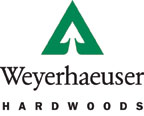
Sponsored by: Weyerhaeuser Hardwoods
Hemlock
 |
| Family Name: Tsuga heterophylla of the Family Pinaceae Common Names: Western hemlock, hemlock, Pacific hemlock, British Columbian hemlock, West Coast hemlock, hemlock spruce, Alaska pine, Western hemlock fir, gray fir, silver fir, Alaskan pineHeight/Weight: The height ranges from 150 to 200 feet, although trees can grow to 225 feet or more with diameters of 3 to 4 feet or more. Average weight is 31 pounds per cubic foot with a specific gravity of 0.45. Properties: Western Hemlock works well with both machine and hand tools. Experts recommend the use of sharp tools for clean, smooth finishes. The wood takes nails and screws well. It can be stained or painted satisfactorily. The wood is free of resin. Western hemlock has a high moisture content when green. |
Western hemlock has picked up a wide range of names over the years although today it is most often known as hemlock or Western hemlock. One possible reason for whittling down the list is the confusion nature of some of the names, such as hemlock spruce or hemlock, gray or silver fir.
The lumber has been marketed in species groups in the past and called Hem-Fir. The Hem-Fir group also includes: California red fir (Abies magnifica), grand fir (Abies grandis), noble fir (Abies procera), Pacific siler fir (Abies amabilis) and white fir (Abies concolor).
The wood has a variety of uses including: dimension lumber, construction, moulding, roof decking, flooring, doors, windows, furniture, cabinetry, paneling, veneer, railway sleepers, plywood manufacture, wood pulp and even newsprint. It is also growing in popularity for architectural millwork, saunas, staircases and spindles.
Properties that make Western hemlock a popular choice, according to the USDA Forest Service, include the wood’s light color, lack of pitch and its ability to take a varnish finish well.
Its light heartwood also makes it a popular choice for applications because it requires minimal bleaching. Western hemlock is still considered the most commercially available of the hemlocks, said Dave Bosley, Weyerhaeuser Hardwoods product manager. “Eastern hemlock is available in tree form, but from a volume of production standpoint, Western hemlock is much more available. Western hemlock’s primary use is for construction lumber and mouldings, but due to the work we have done on drying and grading, hemlock competes with such species as yellow poplar in furniture applications.”
A division of Weyerhaeuser, Northwest Hardwoods offers a brand of Western hemlock which it says is manufactured to standards designed for hardwood lumber.
 |
| Western hemlock’s light color and lack of pitch make it a good species for furniture, cabinetry and millwork. Photo courtesy of Weyerhaeuser |
Jeff Behnke, co-owner of Altura Furniture in Portland, OR, has worked with Western hemlock although the majority of his company’s furniture is made from hardwoods. “It is a domestic softwood with furniture capabilities. It has a nice grain and a good ‘in-between’ color,” said Behnke.
Ryan Hammer, sales manager at Moulding & Millwork in Ferndale, WA, said his company uses Pacific Coast hemlock, which he considers extremely versatile. “It is pitch and resin free, which eliminates blotching and bleeding through finished surfaces,” Hammer said.
“The mouldings work well with all colors of stain and clear coat finishes,” he added. The properties of the hemlock and its superior stain ability makes it easy to finish mouldings to match doors, floors or cabinetry with a wide range of wood finishes.“ Hammer said durability is also a major factor as is the availability of long lengths. Moulding & Millwork gets most of its raw material from British Columbia and some from Southeast Alaska, Washington and Oregon.
Drying Properties
According to Bear Creek Lumber, kiln or air-dried Western hemlock is very stable with little tendency to cup, check or twist.
 |
| Western hemlock is growing in popularity for interior work, including mouldings and trim. Photo courtesy of Moulding & Millwork. |
“As far as drying time goes, it depends on the application,” Bosley added. “For construction lumber applications, hemlock can be dried quite rapidly. The moisture is content is left relatively high as well, in the low 20 percent. For appearance applications, such as furniture or cabinets, hemlock needs to be dried slower, longer and be conditioned as well.”






Have something to say? Share your thoughts with us in the comments below.